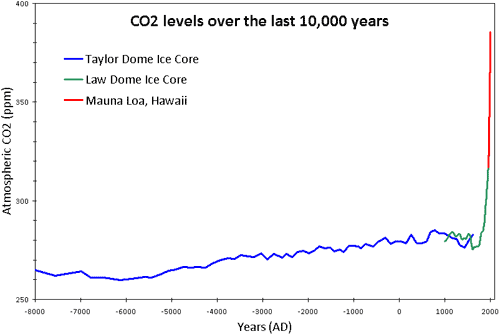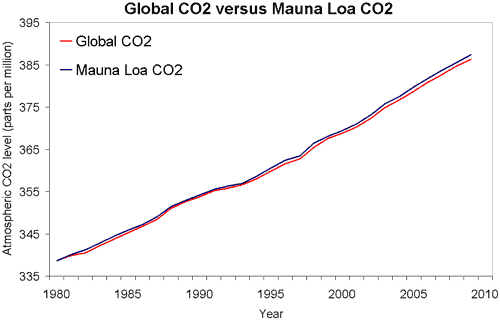
Figure 1: CO2 levels (parts per million) over the past 10,000 years. Blue line from Taylor Dome ice cores (NOAA). Green line from Law Dome ice core (CDIAC). Red line from direct measurements at Mauna Loa, Hawaii (NOAA).
What The Science Says:
The trend in CO2 at Mauna Loa is practically identical to the global trend because CO2 mixes well throughout the atmosphere. The global trend is calculated from hundreds of CO2 measuring stations and is consistent with independently measurements from satellites.
Climate Myth: Mauna Loa is a volcano
'Mauna Loa has been producing a readout which supports Manning's predetermined goal by showing steady growth in atmospheric CO2 concentrations since 1959. Just thirty miles from the observatory, Kilauea's Pu`u O`o vent sends 3.3 million metric tons of CO2 into the atmosphere every year. Pu`u O`o sends into "the undisturbed air" near "the remote location" the equivalent to yearly CO2 production from an average city of 660,000 people.' (Andrew Walden)
The following graph shows atmospheric CO2 levels over the last 10,000 years. It includes ice core data for CO2 levels before 1950. For values after 1950, direct measurements from Mauna Loa, Hawaii were used.

Figure 1: CO2 levels (parts per million) over the past 10,000 years. Blue line from Taylor Dome ice cores (NOAA). Green line from Law Dome ice core (CDIAC). Red line from direct measurements at Mauna Loa, Hawaii (NOAA).
Mauna Loa is often used as an example of rising carbon dioxide levels because its the longest, continuous series of directly measured atmospheric CO2. The reason why it's acceptable to use Mauna Loa as a proxy for global CO2 levels is because CO2 mixes well throughout the atmosphere. Consequently, the trend in Mauna Loa CO2 (1.64 ppm per year) is statistically indistinguishable from the trend in global CO2 levels (1.66 ppm per year). If global CO2 was used in Figure 1 above, the result "hockey stick" shape would be identical.

Figure 2: Global atmospheric CO2 (NOAA) versus Mauna Loa CO2 (NOAA).
The following video is a graphic example of where our data for CO2 levels comes from. It shows surface measurements of CO2 varying over different latitudes from 1979 to 2006. The graph is created by Andy Jacobson from the NOAA and includes a global map displaying where the measurements are coming from, a comparison of Mauna Loa CO2 to South Pole CO2 and the graph expands at the end to include ice core measurements back to the 19th Century.
Satellite data is consistent with surface measurements and present a fuller picture of global CO2 concentration. The next video shows global distribution of mid-tropospheric carbon dioxide. This data comes from the Atmospheric Infrared Sounder (AIRS) on the NASA Aqua spacecraft. Superiposed over the global map is a graph of carbon dioxide observed at the Mauna Loa observatory.
 |
The Skeptical Science website by Skeptical Science is licensed under a Creative Commons Attribution 3.0 Unported License. |